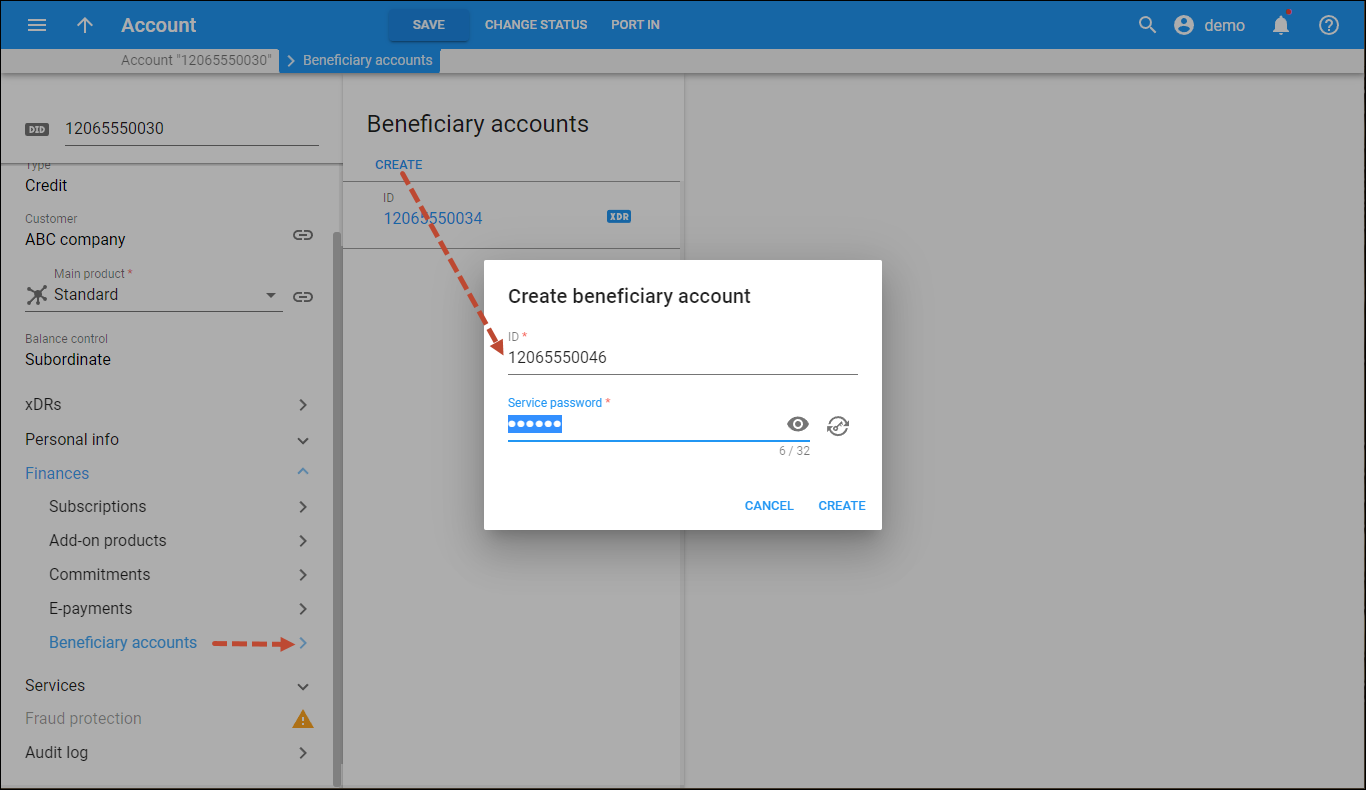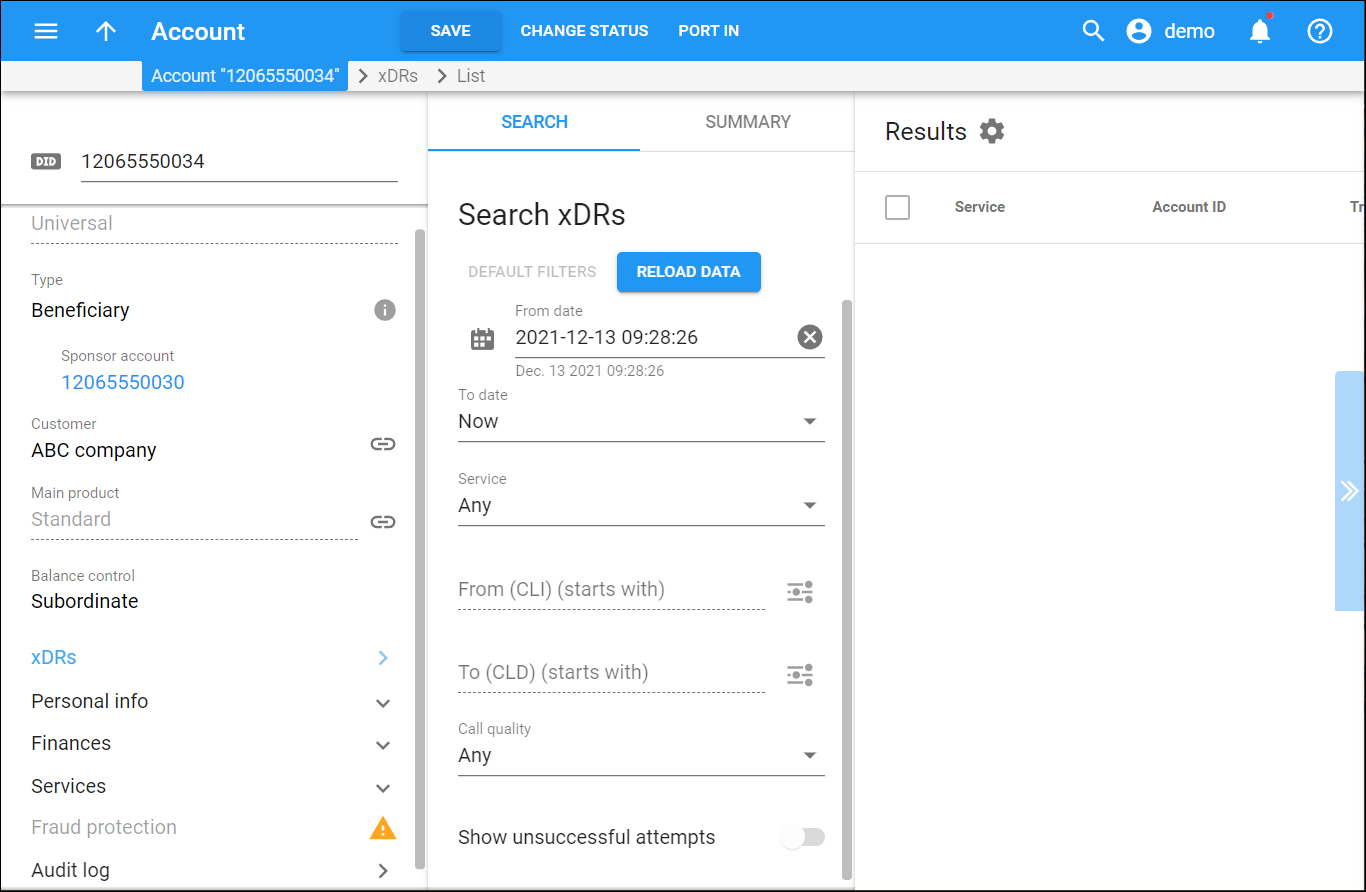Customer status
Please note that when no status is displayed, the customer is active and their services are available. The status displayed depends upon priority. In the list below, the status is indicated in the Priority column. Number 1 corresponds to the highest priority. A customer may have the following status:
Customer statuses and service availability
In the tables below you can see whether services are allowed or denied depending on a customer status, a type of service, and overdraft protection settings.
-
The Overdraft Protection setting for the accounts’ product is the following: the Remaining balance requirement option is set to No Restriction (the default behavior).
Customer status Type of service Toll-free Chargeable Credit exceeded/No available funds allowed The toll-free services are denied for accounts under reseller customers if the reseller’s credit limit is exceeded.denied The chargeable services are allowed for debit accounts.Spending limit reached denied denied Blocked denied denied Suspended/Service limited Service availability depends on the Allow zero charged services for suspended users option. When the option is disabled, no services are provided to end users. When the option is enabled, only toll-free services are available. Suspension delayed allowed allowed Payment frozen allowed allowed Provisionally terminated denied denied Closed denied denied Exported denied denied Export in progress (billing paused) Service availability on the target system is the same as on the source system before the migration. -
The Overdraft Protection setting for the accounts’ product is the following: the Remaining balance requirement option is set to Positive amount available.
Customer status Type of service Toll-free Chargeable Credit exceeded/No available funds denied denied Spending limit reached denied denied Blocked denied denied Suspended/Service limited Service availability depends on the Allow zero charged services for suspended users option. When the option is disabled, no services are provided to end users. When the option is enabled, only toll-free services are available. Suspension delayed denied denied Payment frozen allowed allowed Provisionally terminated denied denied Closed denied denied Exported denied denied Export in progress (billing paused) Service availability on the target system is the same as on the source system before the migration.
Reseller statuses affect service availability in the same way, assuming that accounts do not inherit additional statuses from their customer (i.e., the customer is active and can use the services).
Account statuses
Please note that only one status is displayed in an account although the account may inherit additional statuses from the customer. The status displayed depends upon priority. In the list below, the status is indicated in the Priority column. Number 1 corresponds to the highest priority. An account may have one of the following statuses:
When no status is displayed, the account is active and services are available.
You can separate service and billing configuration for particular accounts. Accounts with only a service configuration are called beneficiary accounts. Beneficiary accounts are linked to regular accounts and inherit their billing configuration – balances, quotas, and tariff rates. In other words, a regular account “sponsors” its beneficiaries.
When a beneficiary account uses the service, charges and quota consumption apply to the sponsor. Likewise, the xDRs are created for the sponsor although the beneficiary is the actual user of the service.
In contrast with using account aliases, beneficiary accounts can have an individual service configuration (e.g., their own SIM card, individual extension, or different service policy). You can only configure the service features for the services included in the sponsor’s main product. Customer can access the self-care portal for their beneficiary accounts to configure the individual service features. For example, to configure the auto-attendant on a beneficiary account’s self-care portal. Beneficiary account owners can also access their self-care portal where they can edit their personal info, IVR language, or change their call forwarding settings at any time.
Sponsor and beneficiary accounts’ activities
The table below compares the sponsor and beneficiary accounts in terms of their activity:
| Activity | Sponsor accounts | Beneficiary accounts |
|---|---|---|
| Account configuration | Any account automatically becomes a sponsor as soon as a beneficiary account is created under it. To switch off sponsorship for the account, terminate all of its beneficiaries. | A beneficiary account can only be created from scratch under a regular account. You cannot convert a beneficiary account into a regular one or make it a sponsor. |
| Service configuration | Can have an individual service configuration that is different from the beneficiaries. | Can have an individual service configuration (e.g., enable voicemail or assign a different access policy). You can override the service features at the account level. |
| Product configuration change | Allowed. You can change/modify the main product (e.g., add a new service or change the tariff), assign/remove add-ons. | Forbidden as the beneficiary account inherits its product configuration from the sponsor. |
| Volume discount plan usage | Shares its volume discount plans with all its beneficiaries. You can add volume discounts, quotas and service wallets. | Uses the volume discount plans assigned to the sponsor. When a volume discount plan is finished or the CLD is not included in the destination group set, charges apply to the sponsor. |
| Subscription assignment | Allowed via add-ons and also directly. All recurring charges apply to the sponsor. | Restricted. The sponsor account bears the recurring charges of its beneficiaries. |
| xDR history | Includes its own xDRs and xDRs created on behalf of all beneficiaries. These xDRs contain the beneficiary account ID. | Shows the sponsor’s xDRs created on behalf of a beneficiary account. |
| Balance and payments | Sponsor accounts see their own balance/available funds. Account owners can make credit card payments and top-ups via vouchers. | Beneficiary accounts see their sponsors’ balance. Account owners are forbidden to make payments and top-ups. |
| Life cycle | Independent from beneficiaries. When a sponsor account expires, services for beneficiaries are blocked. | Independent from sponsor. The date of the last usage is updated for both sponsor and beneficiary accounts. The account’s expiration does not affect service availability for the sponsor. |
| Status change | Any status change affects service availability for both sponsor and beneficiary accounts. For example, when a sponsor is blocked, services are denied both for it and for its beneficiaries. | The status of the beneficiary account does not affect its sponsor yet the beneficiary account is subject to the sponsor’s status change. |
| Self-care access | Allowed. | Allowed. |
| API access under account realm | Allowed. | Allowed for the activities of a beneficiary account. |
With beneficiary accounts, you can offer shared buckets to your business customers and let them optimize their service consumption. For example, let your business customers share quotas among a certain set of their accounts (e.g., grant 500 minutes of international calls for all employees in the Sales department while the Support department receives 100 minutes). To meet the customer’s request, your administrator creates a sponsor account for the Sales department, assigns a 500-minute quota to it, and then creates the appropriate number of beneficiary accounts under it. Likewise, your administrator creates sponsor and beneficiary accounts for the Support department with the 100-minute shared quota assigned to the sponsor. As a result, customers optimize their service consumption and their customer experience improves.




